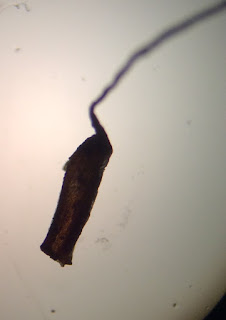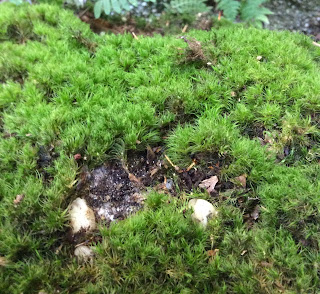

Figure 2:
The left-hand picture is Leskea
gracilescens in a stronger source of lighting so its horizontal growth,
indicating it is a pleurocarp, is better seen. Wetting the specimen did not
drastically change its morphology as the phyllids remained close to the stem. The
right-hand picture is the phyllids of Leskea
gracilescens at 400X magnification. The phyllids are ovular in shape with a
pointed tip and a noticeable midrib.
Name:
Leskea
gracilescens
Common Name: Necklace Chain Moss
Family:
Leskeaceae
Collection Date:
September 1, 2016
Habitat:
Tree bases in flood plains or along streams, and logs, and occasionally on
rock.
Location:
Near the base of a conifer on Slagle Road, OH.
Description: Small
and grows on trees. Looks like a mat of little dark green threads. The
leaves are less than 1 mm long and are held close to the stem when dry but
extend out when wet. They are ovate in shape or ovate-lanceolate with a single
faint midrib, and the cells have a single papilla. These leaves are concave at the
base and biplicate at the base with two tiny folds. The papillae are best seen
under the compound scope by making a slide that includes branches. A series of
tiny bumps can be seen along the backs of the leaves. This moss also has
paraphyllia, which are little leaf-like or thread-like structures growing along
the stem. They can be found by stripping off most of the leaves from the stem
and scanning up and down the stem. The capsules are cylindrical, 2-3 mm long,
and fairly erect.
Key Used:
McKnight, K.B.; Ropher, J.R.; Ward, K.M.; and Perdrizet, W.J. 2013. Common Mosses of the Northeast and
Appalachians, Princeton University Press, Princeton, New Jersey.
Keying Steps:
Introduction Key pp.
16-17
Pleurocarp that has ovate
leaves with midrib.
Key VII: pp. 365-369
1. Plants not pinnately,
but sparsely or irregularly branched (not feather or fernlike)….10
10. Stems either branched
nearly to base or sparsely branched, but without a “trunk and crown”…13
13. Plants on various
substrates in moist to dry habitats (usually not dripping wet when
collected)…19
19. Plants small
(branches mostly shorter than 2 cm and thinner than 1 mm); leaves <1
mm long…25
25. Leaf tips pointed,
not broken off…26
26. Leaves when dry held
close to stem and cupped so branches look like tiny necklace chains; leaves
spreading when wet…27
27. Leaves straight;
capsules straight…Leskea gracilescens…p.
265
Specimen #5: Atrichum altecristatum, Wavy Starburst
Moss
Figure 1: The
left-hand picture is the Atrichum
altecristatum specimen on its original substrate. It was found on dry soil
at the base of a deciduous tree. The right-hand picture is the same specimen in
better lighting. Notice the curly and wavy the branches on this acrocarp, or
moss that grows vertically, as well as the red “fuzz” toward the bases of the
branches.
Figure 2:
The left-hand picture is a branch from Atrichum
altecristatum after being exposed to water. Notice the starburst shape that
gives the moss its common name of Wavy Starburst Moss. The right-hand picture
is a phyllid, or leaf, at 400X magnification. The edges of the phyllid is wavy,
giving this moss the name Wavy Starburst Moss, as well as serrated with tiny
“teeth” and has a long, lance-like shape as well as a noticeable midrib.
Name: Atrichum
altecristatum
Common Name: Wavy Starburst Moss
Family: Polytrichaceae
Collection Date: September
3, 2016
Habitat:
Atrichum altecristatum grows on soil in forests along trails and roads.
Location: Near
the base of a deciduous tree alongside a mowed trail on Slagle Road in Ohio.
Description: Star-like
green leaves extending out from the center when wet and looking dead and
contorted when dry. The leaves are undulate which gives its wavy name, and
teeth are found on the undulations on the back of the leaf and double teeth along
the leaf margins from halfway up the leaf to the tip. Has a long rostrate (with
protruding “nose”) operculum which protects the developing spores in the
capsule until they are ready to be dispersed.
Key Used:
McKnight, K.B.; Ropher, J.R.; Ward, K.M.; and Perdrizet, W.J. 2013. Common Mosses of the Northeast and
Appalachians, Princeton University Press, Princeton, New Jersey.
Keying Steps:
Introduction Key: pp.
16-17
Acrocarp that has lance
leaves with midrib.
Key II: pp. 342-350
1. Plants darker green, yellow
green, or brownish black, shoots loosely associated or if densely packed then
not in domed mounds; leaves flat or folded but not tubular, with midrib usually
visible at least at base of leaf…3
3. Plants on soil, rocks,
trees, or logs in dry areas, or if wetter areas, not submerged in water; leaves
not folded at base…4
4. Leaf surface rippled
or wavy when wet…5
5. Leaf midrib
conspicuous to leaf tip (extra strips of tissue running along their length)…6
6. Midrib fills <
¼ width of upper leaf; leaves 0.7-2 mm wide…7
7. Plants 1-3 cm tall;
lower stems often matted with rust-colored fuzz…Atrichum altecristatum…p. 69
Specimen #6: Dicranum montanum, Crispy Broom Moss/Mountain Fork
Moss
Figure 1: Dicranum montanum on its original
substrate. This specimen was found on top of a very large boulder. Right-hand
picture is a zoomed in shot so that the specimen’s acrocarpous growth is
visible.
Figure 2:
The left-hand picture is a close-up of Dicranum
montanum. Notice how the leaves are hair-like in shape and random in orientation,
not entirely appearing to be “swept” in one direction. The right-hand picture is the
phyllid of Dicranum montanum at 400X
magnification. The shape of this phyllid is hair-like in shape and has a
noticeable midrib.
Name: Dicranum
montanum
Common Name: Crispy Broom Moss or Mountain Fork Moss
Family: Dicranaceae
Collection Date: September
15, 2016
Habitat: Common
on bark at the base of trees, as well as on logs, rocks, and stumps.
Location: On
the topside of a boulder in Nelson Ledges, OH.
Description: Small,
short, cushion moss with crowded 2-4 mm lance-shaped leaves that are tightly
twisted when dry, erect and curved when wet. Often it is found with weak branches
with strongly crisped tiny leaves. The plant reproduce asexually when they fall
off, since each branchlet can grow into a plant. When capsules are present,
they are erect. Microscopically the leaves have one layer of distinct enlarged
reddish brown alar cells at the base of the leaf; this distinguishes them
from Dicranella, which is another small cushion moss. The upper
part of the leaf is keeled and has quadrate cells.
Key Used:
McKnight, K.B.; Ropher, J.R.; Ward, K.M.; and Perdrizet, W.J. 2013. Common Mosses of the Northeast and
Appalachians, Princeton University Press, Princeton, New Jersey.
Keying Steps:
Introduction Key: pp.
16-17
Acrocarp with hair-like
phyllids.
Key I: pp.341-342
1. Plants larger than 1
cm tall; usually in forests on soil, rock, logs, or trees….3
3. Leaves irregular in
orientation with tips pointing in various directions…5
5. Plants small, usually
0.5-3 cm tall; leaves up to 3 mm long…Dicranum
montanum…pp.41
Specimen #7: Plagiomnium ciliare, Saber Tooth Moss
Figure 1: Plagiomnium ciliare on its original substrate. This specimen was found on
a boulder.
Figure 2: Left-hand is an up-close picture of a single “branch”. Notice its interesting
and almost fern-like morphology. Right-hand picture is the phyllid of Plagiomnium ciliare at 400X
magnification. It is ovate in shape with a noticeable midrib. The serrated
edges of the phyllid give this moss the name of Saber Tooth Moss.
Name: Plagiomnium ciliare
Common Name: Saber Tooth Moss
Family: Mniaceae
Collection Date: September
15, 2016
Habitat: Shady places on soil, rotten logs, tree bases
and rocks in woods.
Location: On
a boulder in Nelson Ledges, OH.
Description: Leaves
of P. ciliare have single teeth, and there is a border of long
cells which can be seen with a compound microscope. The plants are medium sized
and grow in loose to dense tufts. The leaves can form starburst (fertile) or
fern-like orientations (non-fertile). The teeth on the upper part of the leaf
are 2-4 celled and extend to the base of the leaf even though they may be much
shorter there. Non-fertile stems of the
plant appear flattened (complanate).
Key Used:
McKnight, K.B.; Ropher, J.R.; Ward, K.M.; and Perdrizet, W.J. 2013. Common Mosses of the Northeast and
Appalachians, Princeton University Press, Princeton, New Jersey.
Keying Steps:
Introduction Key:
pp.16-17
Acrocarp with ovate
leaves that has a midrib.
Key III: pp. 350-354
1. Plants 1-15 cm tall…6
6. Leaf margins toothed
at least near tip….7
7. Some leaves may be in
terminal rosettes but many other leaves are attached along entire length of
stem…8
8. Leaf margin from tip
to near base….9
9. Leaves rounded at apex
with midrib extending as a short point, 1½-2X as long as wide; creeping and
upright present; capsule nodding, lid without beak….10
10. Capsules one per stem
tip; creeping stems abundant, often elongate…Plagiomnium ciliare…pp. 141
Specimen #8: Leucobryum glaucum, Pincushion Moss
Figure 1: Left-hand
picture is Leucobryum glaucum found on its original substrate. This specimen
was found on the soil at the base of a deciduous tree. Notice its unique light,
mint-green coloration compared to the nearby yellow-green mosses neighboring
it. Right-hand picture is a close-up of the specimen in a way that its
acrocarpous growth is more noticeable.
Figure 2:
The phyllid of Leucobryum glaucum at
400X magnification. The phyllid has a lance shape with no noticeable midrib.
Notice the rounded and widened part at the base of the phyllid. This is known
as the basal sheathing section.
Name: Leucobryum
glaucum
Common Name: Pincushion Moss
Family: Dicranaceae/Leucobryaceae
Collection Date: September
22, 2016
Habitat: The
edge of woods, along the top of bluffs, and in other wooded areas.
Location: In
the soil at the base of a deciduous tree on a steep incline at Squaw Rock in
South
Chagrin Nature Preserve in Solon, Ohio.
Description: This
moss forms low whitish green mounds on soil. There are clear hyaline cells
forming a layer or two above and below smaller green cells in the leaf. When it
is wet and the clear (hyaline) cells have filled with water it appears to be a
darker green. The leaves are 3-9 mm long consisting of a basal sheathing
section and an extended concave limb. This limb is commonly longer or equal to
the length of the sheathing base.
Key Used:
McKnight, K.B.; Ropher, J.R.; Ward, K.M.; and Perdrizet, W.J. 2013. Common Mosses of the Northeast and
Appalachians, Princeton University Press, Princeton, New Jersey.
Keying Steps:
Introduction key:
pp.16-17
Acrocarp with lance
shaped leaves with no midrib.
Key II: pp. 342-350
1. Plants gray or whitish
green (dry) to light green (wet); shoots very densely packed together forming
domed mounds; leaves tubular in upper half and seemingly without midrib…2
2. Stems 1-9 cm tall;
leaves 4-8 mm long; rarely with capsules…Leucobryum
glaucum…pp. 123
Moss Links:






























